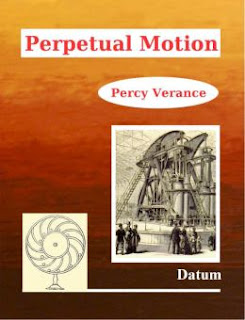People want to be creative, no doubt about this, but people also hate to do the same thing over and over again. Therefore, inventing the machine that could create a workforce with virtually a minimum of input energy is the perfect artifact to substitute the human sweat.
 |
| An early attempt to create a perpetual machine. |
Wilars wrote about this machine the following:
Many a time have skillful workmen tried to contrive a wheel that shall turn of itself: here is a way to make such a one, by means of an uneven number of mallets, or by quicksilver..
 |
| Perpetual Motion. |
Perpetual Motion, by Percy Verance, is the book that explains it all. Perpetual Motion, the EBook recently edited by Datum is a sourcebook that not only collects all the historic efforts and contrivances to create ever-spinning wheels, but in addition to that, in it, we can find the explanations why the machines, or sketches, can't work.
About the sketch shown above he says:
Seven mallets, or arms, each loaded with a heavy weight at the end, are jointed at equal distances to the circumference of the wheel, so that those which happen to have their joints below the diameter of the wheel will hang freely down, but if the wheel be turned round by hand or otherwise, the weights of those which are on the ascending side will, in succession, rest on its circumference, and will, in that position, be carried over the highest part of the wheel and downwards on the descending side, until the arms that bear them are brought into a vertical position and a little beyond it, and then the weight will fall suddenly over and rest on the opposite position on the circumference of the wheel, until its further descent enables it to dangle freely as before..According to modern physics, a truly perpetual motion machine can never be accomplished because it would violate the basic laws (or principles) of thermodynamics.
The most basic of the thermodynamic principles states that:
Energy can neither be created nor destroyed. It can only change from one state to another.In every machinery, in every kind of work, some heat is lost or dissipated, and since heat is a form of energy, the energy output is always less than the energy input, thus, we cannot retrofit the output energy as an input feed, because in the next cycle we are feeding less energy than in the first cycle. No matter how well are machine parts lubricated, every moving part generates friction, thus, everything that moves is a potential energy loser.
However, some people still claim having invented some kind of perpetual motion machinery --and believe it or not-- in some rare cases, they obtain invention patents for their claims. In the EBook Perpetual Motion, the author includes some old cases where patents were granted for those esoteric devices, even when they could not withstand real-world tests.
Registering an invention is not an easy process. It takes specialized attorneys or lawyers. It takes making specialized drawings, and it takes clearly defining your claims. The invention must be new; you must claim and sustain and prove that your patent claims patent are genuinely new. The hardest part is answering the Examiner's comments to your claims. Those people will respond to your invention with a lot of other claims from similar inventors, and you have to prove that your idea is different and your claims are unique.
 |
| Deatil of a patent submission. |
Every society needs good and ingenious inventors. But the process of inventing is not achieved by merely drawing ideas on paper. Those ideas must be in accord with the laws of physics that keep the world running. Ignoring those laws and ignoring those principles is a loss of time, a loss of money, and creativity lost.